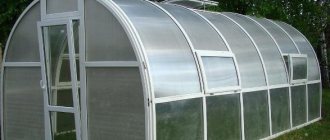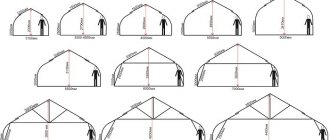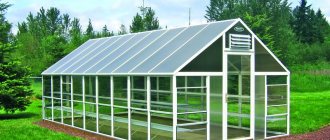The correct choice of heating system for the greenhouse determines how profitable the early cultivation of vegetables, berries or herbs will be for you. After all, the cost of heating a structure can “eat up” the lion’s share of sales revenue! The issue of cheap heating becomes no less pressing if greenhouse cultivation is conceived “for oneself”, and not for the purpose of creating a business. Based on these considerations, a greenhouse stove is the most efficient source of thermal energy. The main thing is to choose the right oven/
Principle of operation
The following can be used as fuel:
- coal and carbon braces;
- pellets from sawdust, seed husks;
- peat;
- household waste;
- firewood.
As practice shows, in the vast majority of cases wood is used.
The essence of the operation of such a boiler is that its special design ensures long-term burning of wood - sometimes up to 16-24 hours. The logs burn out almost completely, leaving virtually no ash behind. Therefore, you need to clean the oven no more than once every two weeks, which is also very convenient.
Among other positive characteristics:
- the possibility of not only air heating, but also connecting a water circuit;
- independence from electricity and gas supply;
- efficiency – more than 85%;
- ease of operation;
- efficiency.
Long-term combustion in this case is ensured by the pyrolysis process. The fuel does not burn in the chamber, but smolders slowly with minimal air access, releasing a large amount of pyrolysis gases. The latter, in turn, also burn in a separate chamber, releasing additional heat. This duplicated combustion process of one bookmark provides, on the one hand, a longer time (up to 8-10 hours) and, on the other hand, a significant effect compared to traditional furnaces.
What do manufacturers offer?
Stove for greenhouse "Vologda"
This model:
- has high heat transfer;
- economically beneficial;
- You only need to add firewood a couple of times a day;
- has high efficiency - about 80%.
The owner does not need to constantly monitor the operation of the equipment. To supply coolant, special flexible hoses are used, which are connected to the back of the boiler and led to a tank filled with coolant. To ensure water heating to 60 degrees, 30 to 40 minutes are enough.
Price – 4200-5800 rubles.
"Buleryan"
This brand is extremely rarely used for installation in greenhouses, but at the same time it ensures long-term combustion of fuel, thereby maintaining the required temperature.
It looks like a large barrel laid on its side with release tubes attached to it. There are several options, depending on the size. The smallest one passes about five cubic meters of air through the tubes every minute. To ensure that the body does not become hot and is safe, it is treated with special paint.
Among the negative properties:
- lack of a regulator to adjust the temperature;
- not easy to install;
- requires constant monitoring.
Price 8500 – 25500 rub.
Butakov stove
Named after the engineer, professor, who developed it. The operating principle of Butakov’s model is similar to the “Buleryan” described above.
Today, several factories are engaged in the production of such a heating device:
- "Thermofor" - a large one - copied the boiler, but did it very professionally and efficiently;
- "Convection" and others.
In general, all developments are very similar to each other, but there are advantages and disadvantages specific to a particular brand. Consultants in stores will tell you more about them - there you can make your final choice by comparing the products in reality.
Price 9000 – 36000 rubles.
Greenhouse stove “Slobozhanka”
Another high-quality and efficient stove - it has vertical loading of logs. Additionally, a special cylinder is used, which exerts pressure on combustible materials, gradually lowering as they burn out.
You can also connect a water circuit to Slobozhanka, so you can easily create a full-fledged heating system with radiators. “Slobozhanka” can be easily copied by creating a similar oven yourself, as described below!
Making a boiler yourself
The advantages of the devices described above are not only that they will provide the required temperature in the greenhouse for a long time, but also that they can be made independently using ordinary metal.
In this section, we will talk in detail about how to make a stove for a long-burning greenhouse with your own hands, and the video will help you better understand the principles of creating the unit. To do this, you don’t need much - desire, dexterity, ability to use ordinary tools and consumables.
Pre-production
It is best to use metal as it heats up quickly, distributes heat evenly and is ideal for creating forced-air heating.
The basis is, of course, the body - it can be made of:
- sheet steel formed into a cylinder;
- old gas cylinder;
- large steel pipe;
- old metal barrel.
The easiest way is to make a unit from an old barrel. Yes, and it’s not difficult to get it. Therefore, in our instructions we take it as a basis. For the barrel you will need:
- metal pipe for smoke removal;
- metal corner.
Tools you will need:
- welding machine;
- grinder with a disc for working on metal;
- any device for identifying and applying markings.
Sequencing
All work is carried out according to a pre-prepared scheme or drawing
Diagram of the simplest long-burning furnace
First of all, you should prepare the body, that is, the barrel:
- the top cover (if it is not removable) is cut off;
- a hole is cut in the side of the upper part of the barrel, the diameter corresponding to the size of the chimney pipe;
- A square or rectangular hole is cut out at the bottom, through which the logs will subsequently be placed - naturally, you will also need a metal door that fits tightly and ensures tightness.
The body is ready, and therefore it’s time to create other structural elements. In particular, the cut top lid should be slightly reduced in size so that it fits freely into the barrel.
Make a small hole in the middle of your “pancake”. Connect a small diameter pipe to it - oxygen will flow through the hole. A hole that is too large will cause the wood to burn out quickly - it is enough if its diameter is about two centimeters.
Weld steel strips to the bottom of the “pancake”, which will help strengthen the lid and make the pressure on the wood more effective.
As a result, the firewood will gradually smolder, and the lid will put pressure on it and gradually lower. By the way, by the level of its lowering you can determine when to reload fuel again.
To make the stove safe, it should be installed on legs - also use a metal corner for this. Make four corner pieces of equal length and weld them to the barrel. Weld small metal plates at the bottom of the corners, which will provide additional stability to the solid fuel boiler you created.
Choosing a location for installation
The main task of the furnace is to uniformly heat the soil. Experienced gardeners recommend placing the installation in the center of the greenhouse so that the heat from it spreads equally in all directions.
The installation must be deepened by approximately half the height, leaving access for storing firewood in the lower compartment of the structure. This arrangement of the system will allow the soil and air to be heated evenly, and is the most acceptable from the point of view of fire safety.
If the floor and lower part of the walls in the greenhouse are lined with bricks or tiles, you can install the stove in the corner. But in any case, precautions and fire safety measures should be observed to protect the premises and future harvest from accidental fire.
It is important to stretch the smoke exhaust pipe in a horizontal position away from the stove, and then attach a vertical pipe through the adapter. This will prevent carbon monoxide from entering the greenhouse. Although a small amount of smoke inside the building will not harm the plants. If the chimney length is more than 6 m, the draft in the pipe will become significantly worse.
Types of heating and types of stoves
Greenhouses are heated using several methods:
- biological;
- electrical;
- air;
- gas;
- stove.
Stove heating is the most economical heating option, which allows the use of most types of fuel. They can work on wood, coal, gas and even pellets.
Stove heating has one significant drawback - drying out the air due to the rapid heating of the equipment.
Stove heating using sawdust, which is waste from wood processing enterprises. Therefore, the purchase of this fuel does not require large expenses. To build a sawdust stove, you need to purchase a tin barrel, preferably a couple of barrels, a gas cylinder and a piece of pipe.
- A waste oil stove is an economical heating option with a long burning time. Used oils are disposed of from any vehicle fleet, so fleet workers will be happy to share the oil.
- To heat the greenhouse in the cold season, potbelly stoves are used, which provide good heating.
- Kuznetsov's brick heating stove is of particular interest to gardeners due to its high efficiency (80%). However, the brick stove body must be insulated with basalt material.
- A miracle diesel stove is an excellent solution for a greenhouse where there is no connection to the central heating system. The stove is used both as an additional and as the main source of heat.
There are many types of stoves for heating greenhouses, which differ from each other:
- principle of heat transfer;
- convection;
- radiation;
- main and additional parts;
- fuel combustion chamber;
- pipes for air supply.
Method No. 4: furnace running on waste oil
Used oil is cheap and it is possible to negotiate with the owners of the nearest service station about the purchase of fuel. Such a furnace will have the following components:
- chimney;
- hole into which liquid oil is supplied;
- pressure regulating valve;
- waste oil reservoir.
The upper part of the structure will become very hot, which means it can be used to heat water or cook food. To create it you need to use the following scheme:
Used oil is a cheap and accessible fuel
The chimney will be a pipe located in a vertical position. The essence of the design is as follows:
- Fuel is poured into the oil container. 2 to 3.5 liters is enough.
- Next, a paper wick is ignited, which is installed in the hole for the stove.
- The hole is covered with a flap. You need to leave a gap of up to 2 cm.
- When the oil ignites, its combustion can be controlled by the position of the damper.
- In just 5 minutes the structure will begin to work and heat the greenhouse.
- The adjustment consists of adding fuel and adjusting the throttle position.
A greenhouse heater only requires oil to heat it. The stove is powerful, so it can even be connected to a water heating circuit.
What have we learned?
From an article on biology (6th grade) we learned that in many plants, the roots perform, in addition to the main ones, some additional functions, which are associated with corresponding modifications of the roots. Although these functions are considered additional and specific, they still relate to the support and nutrition of the plant. The types of modified roots are very diverse.
Solid fuel stove potbelly stove
Outside cities, firewood is the most affordable, so the most popular long-burning stove is a wood-burning stove. They heat it not only with firewood from the ridge, but also with waste wood - shavings, sawdust, waste fiberboard and chipboard, small brushwood, straw, etc. There are many heating systems using wood and wood waste. Let's consider the most efficient ones, the efficiency of which is more than 70%.
A potbelly stove is an economical stove that appeared in Russia after the revolution, during the times of military communism, when many had to endure hardships. The genius of the potbelly stove is that it warms up instantly, as well as the simplicity of its design, the prototype of which was the Russian stove. The upper door is for storing firewood, the lower one is for regulating combustion by supplying air through the slightly open door.
The purpose of a potbelly stove: to keep at least one room warm at minimal cost. When using coal, the grate is removed, and air from the ash pit is directed into the firebox
It is important not to overcrowd it - the volume of the bookmark should be no more than a quarter of its volume. The afterburning chamber is a long horizontal or slightly inclined part of the chimney
Made of metal, it retains heat in the room.
When fired, any potbelly stove becomes red-hot, so its upper surface can be used as a cooking surface. A screen should be installed on the sides at a distance of 40-60 mm from the stove. It protects the room from IR rays and maintains the temperature at an optimal level.
Using a potbelly stove, you can make a homemade long-burning wood-burning boiler. To do this, instead of a screen, a U-shaped metal water heater is installed. The distance between the furnace body and the boiler should be the same as the screen indentation.
Sources
- https://eteplica.ru/otoplenie-i-ventilyaciya/kak-sdelat-pech-dlitelnogo-goreniya-dlya-teplicy.html
- https://teplofan.ru/pechi-i-kaminy/pech-dlya-teplic
- https://kotel-otoplenija.ru/pechi-dlitelnogo-goreniya-dlya-otopleniya-zimnix-teplic-kratkij-obzor-modelej
- https://teploguru.ru/pechi/pechi-dlitelnogo-goreniya.html
- https://KaminGid.ru/pech-slobozhanka-svoimi-rukami
- https://SdelayPechi.ru/vidy/firmennye/pech-slobozhanka.html
- https://kaminguru.com/pech/slobozhanka.html
- https://oteplicah.com/kommunikacii/otoplenije/76-pechi-dlya-teplic-dlitelnogo-goreniya
Greenhouse heating options
Familiarize yourself with the main features of the systems most commonly used to heat greenhouses.
Steam heating
Steam heating
This option should be considered if it is possible to connect the heating of the greenhouse to the heating system of the house.
Pipes laid from the house to the greenhouse require high-quality insulation. The boiler power reserve must be sufficient to provide the required level of heating for both the house and the greenhouse.
There is also a way to organize autonomous steam heating. In this case, the boiler is installed in the greenhouse. Pipes and batteries are connected to the heating unit, and the coolant supply is ensured. Water is traditionally used as a coolant.
To ensure forced circulation of water, the system is usually equipped with appropriate pumping equipment.
Air heating
Air heating
To organize air heating, air heated in the firebox of a special boiler is used. Such heating is characterized by minimal monetary costs for fuel and high thermal efficiency.
Air heating
About half an hour after starting the equipment, the air temperature in the greenhouse can rise by 20 degrees. An additional advantage of the system is that there is no need to use any intermediate coolants.
Gas heating
Gas heating
In such a system, heat is generated as a result of gas combustion. The system can be configured either by connecting to a permanently supplied gas or by using fuel in cylinders.
Gas heater
During operation of the system, there is an intensive intake of air from the heated room, accompanied by the release of water, carbon dioxide and other waste that pose a danger to humans and, of course, plants. In view of this, the installation of gas heating will entail additional costs for organizing the ventilation system.
This type of heating is well suited for small greenhouses. When used over large areas, the costs and complexity of maintenance may be prohibitively high.
Electric heating
Electric heating
Modern electric heating units allow you to efficiently heat a greenhouse without much effort.
Among the main advantages of such devices, it should be noted that during their operation, only the heating of plants and soil occurs. The air does not warm up. It gradually receives heat from the heated earth. This allows you to equip the most efficient and economical heating system.
IR heaters
Modern systems are equipped with sensors and temperature controllers, which provide ample opportunities for dividing the greenhouse into different thermal zones and providing the most comfortable conditions for each group of plants.
Prices for popular models of infrared heaters
IR heaters
Stove heating
Greenhouse stove
The main unit in such a heating system is a solid fuel boiler, usually burning wood or coal.
The simplest stove heating system includes a solid fuel boiler and a smoke exhaust pipe leading from the greenhouse to the street. Additionally, you can equip the system with pipes and radiators, which will allow you to organize the most efficient and high-quality heating.
Both conventional wood-burning stoves and modern long-burning boilers are available on the market. Such devices do not require frequent fuel supply and use it as efficiently as possible.
Installing a solid fuel boiler directly in the greenhouse will lead to drying out of the air and soil, as a result of which the cultivated plants may simply die. To prevent this from happening, when installing a solid fuel boiler in a greenhouse, it is necessary to equip an air humidification system. Usually it is enough to install a large container of water.
Stove heating
Stove heating of a greenhouse is the most popular heating option. In addition, there is nothing complicated in setting up such a system - even a novice master can handle the job. Also, solid fuel heating unconditionally outperforms electric heating in terms of cost. That is why the procedure for organizing heating of a greenhouse will be considered using the example of stove heating.
Heating boilers based on potbelly stoves
To heat a multi-room house, you will need a flow-through water heating circuit with a long-burning solid fuel boiler. Such a system can be configured in two ways. The principle underlying the potbelly stove is taken as a basis.
The first method or boiler No. 1
The natural vortex is replaced by forced pressurization, and pyrolysis is divided into two stages in space: a pyrolysis chamber, a nozzle (nozzle) that forms a flow of pyrolysis gases, and a combustion chamber. The nozzle is made so that there are no parasitic turbulence behind the mass of fuel. To ensure complete control over the process, through blowing is necessary.
Features of direct-flow and heat-storing pyrolysis boilers:
- The temperature in the combustion chamber is a parameter necessary to control the process.
- Optimization of heat dissipation is directly proportional to the intensity of the boost.
- The system is insensitive to the temperature of the walls of the combustion chamber, so the water heater can be installed in a technically convenient way.
- Additional loading is possible at any stage and in any acceptable quantity.
The efficiency of once-through boilers can be above 90%. They require power to operate. When switching off, to further start the system, it is necessary to remove the sintered mass and make a new filling in the firebox.
The second method or boiler No. 2
A pyrolysis boiler with a water heater, which does not require electricity or automation, works on the principle of counteracting the two laws of the square-cube. This refers to the filling of fuel and the lining of fireclay bricks. Brick kiln operation algorithm:
- At the beginning, the intensity of the pyrolysis process is ensured by the sublimation of the lightest volatiles. The “first heat” travels through the smoke circulation, being absorbed by the lining.
- At the stationary stage, the lining serves as a thermal buffer: when there is excess pyrolysis heat, it absorbs it and releases it when it cools.
- Upon completion of carbonization of the fuel, heat is gradually released by the lining, preventing the temperature from falling below the critical point.
in or coal into a boiler with a thermal buffer is produced gradually. Sharp temperature fluctuations are contraindicated for her. If too sluggish fuel is used, it may stall. If it is too flammable, there is a risk of an emergency. If the first heat is not suppressed, the efficiency will not exceed 76-78%, since instantaneous heat transfer from the lining to the outside is excluded.











